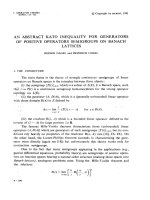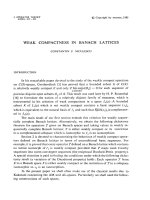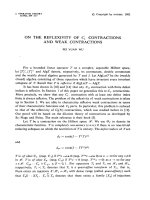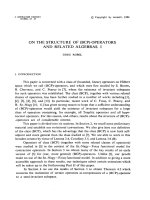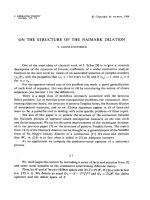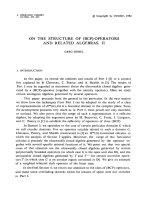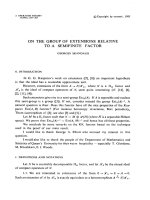Báo cáo toán học: "Bounding the number of edges in permutation graphs" pdf
Bạn đang xem bản rút gọn của tài liệu. Xem và tải ngay bản đầy đủ của tài liệu tại đây (149.99 KB, 9 trang )
Bounding the number of edges in permutation graphs
Peter Keevash
∗
Po-Shen Loh
†
Benny Sudakov
‡
Submitted: Dec 10, 2005; Accepted: Apr 27, 2006; Published: May 5, 2006
Mathematics Subject Classification: 05C35, 20B30
Abstract
Given an integer s ≥ 0 and a permutation π ∈ S
n
,letΓ
π,s
be the graph on n
vertices {1, ,n} where two vertices i<jare adjacent if the permutation flips their
order and there are at most s integers k, i<k<j, such that π =[ j k i ].
In this short paper we determine the maximum number of edges in Γ
π,s
for all s ≥ 1
and characterize all permutations π which achieve this maximum. This answers an
open question of Adin and Roichman, who studied the case s =0. Wealsoconsider
another (closely related) permutation graph, defined by Adin and Roichman, and
obtain asymptotically tight bounds on the maximum number of edges in it.
1 Introduction
We begin with standard notation. Let π ∈ S
n
be a permutation and let π(i)denotethe
image of i, where we consider π as a bijection from [n]={1, ,n} to itself. We express
permutations as linear arrangements of [n] by listing images in order as [π(1), ,π(n)].
For example, [2, 5, 1, 3, 4] represents the permutation that maps 1 → 2, 2 → 5, 3 → 1,
4 → 3, 5 → 4. Note that in the context of list notation π
−1
(i) denotes the position of i
in the permutation when π is written in a list form and π
−1
(i) <π
−1
(j)hasthesimple
interpretation that in π the number i appears before the number j.
Definition 1.1 Given an integer s ≥ 0 and a permutation π ∈ S
n
,
∗
Department of Mathematics, Caltech, Pasadena, CA 91125. E-mail: Research
supported in part by NSF grant.
†
Department of Mathematics, Princeton University, Princeton, NJ 08544. E-mail:
Research supported in part by a Fannie and John Hertz Foundation
Fellowship, an NSF Graduate Research Fellowship, and a Princeton Centennial Fellowship.
‡
Department of Mathematics, Princeton University, Princeton, NJ 08544, and Institute for Advanced
Study, Princeton. E-mail: Research supported in part by NSF CAREER
award DMS-0546523, NSF grant DMS-0355497, USA-Israeli BSF grant, Alfred P. Sloan fellowship, and
the State of New Jersey.
the electronic journal of combinatorics 13 (2006), #R44 1
• Let Γ
π,s
be the graph on the vertex set [n] in which a pair of vertices i<jis
adjacent if π
−1
(i) >π
−1
(j) and there are at most s integers k, i<k<j, such that
π
−1
(i) >π
−1
(k) >π
−1
(j).
• Similarly, let G
π,s
be the graph in which we connect a pair of vertices i<j as long
as there are at most s integers k, i<k<j,withπ
−1
(k) lying between π
−1
(i) and
π
−1
(j)(i.e., we drop the condition that π
−1
(i) >π
−1
(j)).
These two graphs were defined by Adin and Roichman [1], who studied the maximum
number of edges in Γ
π,s
and G
π,s
when s = 0. This combinatorial problem was motivated
by the observation that the number of edges in Γ
π,0
equals the number of permutations
σ that are covered by π in the strong Bruhat
1
order on S
n
, and the number of edges
in G
π,0
equals the degree of the vertex π in the Hasse
2
diagram corresponding to that
order. Γ
π,0
also appeared in a different context, in work by Bousquet-M´elou and Butler
[2], which focused on the case when Γ
π,0
is a forest; this stemmed from a question related
to Schubert varieties. The second graph, G
π,0
, was recently considered by Felsner [5],
who rediscovered Adin and Roichman’s bound on the maximum number of edges in G
π,0
while studying (2-dimensional) rectangle graphs. These graphs are actually equivalent to
G
π,0
, but defined in geometric language. Their definition naturally generalizes to higher
dimensions, and Felsner’s paper also contains an asymptotic bound for the maximum
number of edges in 3-dimensional box graphs.
Adin and Roichman [1] noticed that there are no triangles in Γ
π,0
and therefore by
Tur´an’s Theorem [6] (see also [4]) this graph contains at most n
2
/4 edges. They also
characterize all permutations that achieve this maximum. For general s>0 Adin and
Roichman again used Tur´an’s Theorem together with the fact that Γ
π,s
does not contain
a complete graph on s + 3 vertices to deduce that the number of edges in Γ
π,s
is bounded
by
1 −
1
s+2
n
2
2
. On the other hand, they conjectured [3] that this bound is far from being
best possible and for large enough n the optimal permutations have the following form
π
s,m
n
=[m + s +1,m+ s +2, ,n,m+ s, m + s − 1, ,m+1, 1, 2, ,m], (1)
where m equals
n−s
2
or
n−s
2
. These permutations have a particularly simple structure,
which is most transparent in the context of the permutation diagrams in Figure 1. The
corresponding graph Γ
π,s
consists of three parts of size s,
n−s
2
and
n−s
2
. Each vertex
in the part of size s is adjacent to all other vertices in the graph, and the edges between
the parts of size
n−s
2
and
n−s
2
form a complete bipartite graph, giving a total of
n−s
2
n−s
2
+ s(n − s)+
s
2
edges. Our first theorem proves that the permutations π
s,n
m
are indeed optimal, and classifies all optimal configurations.
1
The strong Bruhat order is the transitive closure of the following partial order relations. For
each pair of integers a<bin {1, ,n}, introduce the relation π<σif and only if [π(1), ,π(n)]
and [σ(1), ,σ(n)] are identical except for the transposition of a and b,anda appears before b in
[π(1), ,π(n)].
2
Given a partially ordered set (S, <), recall that x covers y if x>ybut there does not exist z for
which x>z>y. The Hasse diagram is the graph with vertex set S and an edge between every pair of
vertices x, y ∈ S for which either x covers y or vice versa.
the electronic journal of combinatorics 13 (2006), #R44 2
Permutation diagram Schematic form
Figure 1:
Optimal permutations for Γ
π,s
. A permutation diagram for π, as exhibited on the left, is a
plot of the n points {(i, π(i))} in the lattice [n] × [n]. We will often draw the plots schematically, as in
the diagram on the right.
Theorem 1.2 Suppose s ≥ 1, n ≥ s +2 and let f(s, n) be the maximum number of edges
in Γ
π,s
as π runs over all permutations in S
n
. Then
f(s, n)=
n − s
2
n − s
2
+ s(n − s)+
s
2
.
Moreover, the only permutations that achieve this maximum are π
s,m
n
from (1), where m
equals
n−s
2
or
n−s
2
, except when n = s +3. Then, there is exactly one additional
optimal permutation: [s +3,s+2, ,1].
We stated this theorem only for n ≥ s + 2, as for n ≤ s + 2 it is clear that there is a
unique permutation π =[n, n − 1, ,1] for which f(s, n)=
n
2
and Γ
π,s
is a complete
graph.
When s = 0, Adin and Roichman also proved that the graph G
π,0
with π = π
0,m
n
has
the maximum possible number of edges. One would naturally suspect that π
s,m
n
might
give optimal graphs G
π,s
for all s ≥ 1. Surprisingly, this is not the case and we were
able to construct better permutations. This suggests that the problem of maximizing the
number of edges in G
π,s
has a distinct flavor and is more complex than the corresponding
one for Γ
π,s
. Though we were not able to solve it completely we managed to obtain a
good upper bound on the size of G
π,s
.
Theorem 1.3 Let g(s, n) be the maximum number of edges in G
π,s
as π runs over all
permutations in S
n
. Then
n
2
4
+
23s
12
+ O(1)
n ≤ g(s, n) ≤
n
2
4
+
5s +3
2
n.
For comparison, note that when π = π
s,m
n
the graph G
π,s
has only
n
2
4
+
3s
2
+ O(1)
n
edges.
The rest of this short paper is organized as follows. In the next section we study the
number of edges in Γ
π,s
and prove Theorem 1.2. In Section 3 we construct permutations π
which give larger G
π,s
graphs than those previously known and obtain an upper bound on
the size of such graphs. The last section of the paper contains some concluding remarks.
the electronic journal of combinatorics 13 (2006), #R44 3
2 Maximum number of edges in Γ
π,s
In this section we prove Theorem 1.2. We show by induction on n that if Γ
π,s
has at
least f(s, n) edges then π = π
s,m
n
for m equal to
n−s
2
or
n−s
2
,orn = s +3and
π =[s+3,s+2, ,1]. In the base case n = s +2we can make Γ
π,s
complete by choosing
π = π
s,m
n
=[s +2,s+1, ,1], and this is obviously a unique maximum construction.
Now we give the induction step for n>s+ 2, using the following deletion method.
Given a permutation π and an integer 1 ≤ v ≤ n we can write our permutation π in
list form, and delete v from the list. This produces a list π\{v} with n−1 numbers, which
corresponds to a permutation π
∈ S
n−1
as follows. Let τ
v
(j)bethej-th largest number
in [n] \{v}.Thenπ
is obtained by substituting j instead of τ
v
(j) in the list π \{v}.For
example, if we delete 2 from the permutation [3, 2, 1, 4] ∈ S
4
, we obtain the list [3, 1, 4],
which after substitution, gives the permutation [2, 1, 3] ∈ S
3
. It is easy to see that our
operation has the following property. If the vertices τ
v
(j)andτ
v
(k) were adjacent in Γ
π,s
,
then the corresponding vertices j and k are adjacent in Γ
π
,s
. However, it is possible to
have an edge (j, k)inΓ
π
,s
without having the edge (τ
v
(j),τ
v
(k)) in Γ
π,s
. Thus the number
of edges in Γ
π,s
exceeds the number of edges in Γ
π
,s
by at most the degree of vertex v,
with equality only if for every edge (j, k)inΓ
π
,s
the vertices τ
v
(j)andτ
v
(k) are adjacent
in Γ
π,s
. We assume that Γ
π,s
has at least f(s, n) edges and by induction hypothesis the
number of edges in Γ
π
,s
is at most f(s, n − 1). This implies that every vertex v in Γ
π,s
has degree
d
v
≥ f (s, n) − f(s, n − 1) =
n + s
2
. (2)
Let b be the lowest numbered vertex adjacent to n in Γ
π,s
. Any common neighbor k
of n and b must satisfy b<k<nand lie in π as [ n k b ]. Hence the adjacency
of n and b bounds the number of common neighbors by s and therefore, d
n
+ d
b
≤ n + s.
Combining this with (2), we find that at least one of d
n
or d
b
must be exactly
n+s
2
.
Call that vertex x.Ifbothd
n
= d
b
=
n+s
2
, then choose x = n.Notethatifn + s is
even, we will always choose x = n. Delete x from π and let π
be the new permutation,
as defined above. By the above discussion, we have that the number of edges in Γ
π,s
and Γ
π
,s
are f(s, n)andf(s, n − 1) respectively. Moreover for every edge (j, k)inΓ
π
,s
the corresponding vertices τ
x
(j)andτ
x
(k)inΓ
π,s
are adjacent as well. To determine the
structure of the permutation π we consider several cases.
Case 1: x = n. The deletion operation is particularly easy since we are deleting the
largest number, so π is obtained from π
simply by inserting n somewhere in the list form.
Call this location the insertion point.
Case 1A: n ≥ s +3, n − s odd. By induction hypothesis, π
∈ S
n−1
is precisely π
s,m
n−1
with m =
n−1−s
2
.Notethatπ
s,m
n−1
has exactly
n−1+s
2
= d
n
numbers listed after n − 1,
so if the insertion point is after the occurrence of n − 1, it must be immediately
after n − 1 in order for n (the largest number) to be adjacent to all of them. This
produces π
s,m
n
.
the electronic journal of combinatorics 13 (2006), #R44 4
On the other hand, if the insertion point is before n − 1, then n will not be adjacent
to any of the last m vertices listed in π
s,m
n−1
.Yetd
n
=
n−1+s
2
= n − 1 − m,son
must be adjacent to every other vertex listed in π
s,m
n−1
.Sincen is the largest number,
this forces the insertion point to be right at the beginning of the list. Since π
is
precisely π
s,m
n−1
with m =
n−1−s
2
, this yields the permutation [s+3,s+2, ,1] when
n = s + 3, but for n>s+ 3 it produces
π =[n, m + s +1,m+ s +2, ,n− 1,m+ s, m + s − 1, ,m+1, 1, 2, ,m],
where 2 ≤
n−1−s
2
= m,sod
n
is only max{s +1,
n−1−s
2
} <
n+s
2
, contradiction.
Case 1B: n ≥ s +4, n − s even. Now the induction hypothesis gives us several possi-
bilities for π
: two of the form π
s,m
n−1
,andifn − 1=s +3, also [s +3, ,1]. A
similar argument to the above rules out the possibility that the insertion point is
before n − 1 in all three cases. If π
= π
s,m
n−1
with m =
n−1−s
2
=
n−s
2
, then the only
insertion point after n − 1thatmakesd
n
=
n+s
2
is again immediately after n − 1.
This yields π
s,m
n
. On the other hand, if m =
n−1−s
2
or π
=[s +3,s+2, ,1],
then no insertion point after n − 1givesd
n
=
n+s
2
at all.
Case 2: x = b. We shall show that in fact b = 1. To see this, suppose b = 1. Recall that
we are only in this case if n + s is odd, so by induction π
= π
s,m
n−1
with m =
n−1−s
2
.We
also know that if j, k are adjacent in Γ
π
,s
then τ
b
(j)andτ
b
(k) are adjacent in Γ
π,s
as well.
In particular, τ
b
(1) is adjacent to τ
b
(n − 1), since (1,n− 1) is an edge in Γ
π
,s
. However
n>b= 1 implies that τ
x
(1) = 1 and τ
x
(n − 1) = n. Therefore, there is an edge between
1andn in Γ
π,s
, contradicting the choice of b as the lowest numbered vertex adjacent to
n. Hence b = 1. Now the statement of the theorem is invariant under the transformation
[π(1), ,π(n)] ↔ [n +1− π(n), ,n+1− π(1)], so this case follows from Case 1 by
this symmetry.
This completes the case analysis and the proof of Theorem 1.2.
3 Edge bounds in G
π,s
In this section we prove Theorem 1.3, which gives bounds on the maximum number of
edges in G
π,s
with π ∈ S
n
.
Proof of Theorem 1.3. We start with the upper bound, showing by induction on n
that G
π,s
has at most u(s, n)=
n
2
4
+
5s+3
2
n edges. This trivially holds for n ≤ s +2, as
then u(s, n) ≥
n
2
. Suppose that n>s+ 2. We will show that there is a vertex i with
degree d
i
≤ u(s, n) − u(s, n − 1) =
n
2
+
5s+2
2
+
1
4
. This will complete the induction step.
Let t be the largest numbered vertex that is adjacent to 1 in G
π,s
.Letl and r be the
respective leftmost and rightmost common neighbors of 1 and t, where “left” and “right”
are defined with respect to the order in which the numbers appear when π is written in
list form. Draw the permutation diagram for π, and without loss of generality, suppose
that 1 appears to the right of t (a similar argument will apply to the other case). Figure
2 shows the two possible relative configurations of 1, t, l,andr in the diagram for π.Of
the electronic journal of combinatorics 13 (2006), #R44 5
course, there could be more diagram points to the left, right, or above the part isolated
in Figure 2.
Relative configuration type 1 Relative configuration type 2
Figure 2:
Diagrams for Theorem 1.3. The dotted rectangles are not part of the permutation diagram,
and are drawn in for the purpose of marking regions. We only have to worry about two types of con-
figurations, depending on the relative positions of l and r;ifl is below r, then we need the additional
rectangular region E to complete the cover.
Since l and r are the leftmost and rightmost common neighbors, t is the topmost
neighbor of 1, and 1 is the minimal element in the set {1, ,n}, all diagram points for
common neighbors of 1 and t must lie in the union of the marked rectangular regions A,
B, C, D,andE (but we do not need E if we are in the case of the second diagram). Since
l and t are adjacent, the number of diagram points that lie in region A of the diagram is
bounded by s. Similarly, the number of points in each of regions B, C, D,andE must
also be bounded by s. The set of common neighbors of 1 and t must be some subset of
all of these points, so its size is bounded by 5s + 2 if we are in the first case, and 4s +2
if we are in the second. (The additional 2 comes from counting l and r.) It follows that
d
1
+ d
t
≤ n +5s + 2 and so one of d
1
,d
t
is at most (n +5s +2)/2 <u(s, n) − u(s, n − 1).
This proves the upper bound.
As a lower bound we provide a construction that (asymptotically) differs from it only
in the linear term. Since we are interested in asymptotics, let us make the simplifying
assumptions that s is even and n is a multiple of 3s. Consider the family of permutations
that have diagrams of the form in Figure 3. We can explicitly describe these permutations
in list form by defining the ordered (3s/2)-sublists
A :=
s
2
+1,
s
2
+2, ,
3s
2
,
s
2
,
s
2
− 1, ,1
,
B :=
3s
2
,
3s
2
− 1, ,s+1, 1, 2, ,s
.
Then, the permutations have list form
A +
n
2
,A+
n
2
+
3s
2
, ,A+ n −
3s
2
,B,B+
3s
2
, ,B+
n
2
−
3s
2
,
the electronic journal of combinatorics 13 (2006), #R44 6
Figure 3: Construction for
n
2
4
+
23s
12
+ O(1)
n. The two sides of this construction are of equal size.
where we use the shorthand A + k to denote the (3s/2)-sublist of element-wise translates
of A by k.
It is clear from the diagram that every vertex corresponding to a point on the left half
of the diagram will be adjacent to every vertex corresponding to a point on the right half,
because these diagrams make the definition of adjacency particularly easy to visualize:
two vertices i and j are adjacent exactly when the axis-parallel rectangle with corners
{(π
−1
(i),i), (π
−1
(j),j)} contains at most s other diagram points. Since each half has
size n/2, this gives us the quadratic term. For the linear term, we calculate the internal
degrees of vertices, i.e. the number of neighbors they have in their own half. For extreme
vertices that are one of the leftmost or rightmost 3s points in each half, we will take the
simple estimate that their internal degrees are not negative. A non-extreme vertex in an
(s/2)-run is adjacent to the vertices diagrammed on the right side of Figure 4; this yields
an internal degree of 9s/2 − 1. Any non-extreme vertex in an s-run that is the first or
last vertex of its run (call it an “endpoint vertex”) is adjacent to the vertices diagrammed
on the left side of Figure 4; this yields an internal degree of 7s/2+1. The rest of the
non-extreme vertices in s-runs have internal degree 7s/2+2.
Since there are twice as many vertices in runs of length s as in runs of length s/2, the
total number of internal edges in the two sides is at least
1
2
· n ·
2
3
7s
2
+1
+
1
3
9s
2
− 1
− O(s
2
)=
23s
12
+ O(1)
n,
as claimed.
4 Concluding remarks
Theorem 1.2 settles the Γ
π,s
problem raised in the last section of Adin and Roichman’s
paper, but Theorem 1.3 on G
π,s
still leaves a gap between the constants of 23/12 and
the electronic journal of combinatorics 13 (2006), #R44 7
Adjacency of an endpoint Adjacency of a typical
vertex in an s-run vertex in an (s/2)-run
Figure 4:
Adjacent vertices to a non-extreme endpoint vertex in a run of length s (left hand side), and
to a non-extreme vertex in a run of length s/2 (right hand side). In each case, the vertex in question is
marked by a star.
5/2. We have some preliminary arguments based on the stability method that suggests
that with more work, one could reduce the upper bound to g(s, n) ≤
n
2
4
+(2s + O(1)) n.
Some intuition for this bound can be obtained from the proof of Theorem 1.3, as if the
structure of a permutation is ‘close’ to that of π
s,m
n
then the configuration of the first type
in Figure 2 will not occur for most pairs of vertices. Then we would not need the region
E in the proof, and we would replace the 5s +2with4s + 2. However, the “sufficiently
large” is necessary, because if n =5s + 4, the construction in the left side of Figure 5
gives 1 and t a total of 5s + 2 common neighbors, and it yields a complete graph, which
must be optimal.
Optimal construction for n =5s +4 Asymptotically superior
construction for s =4
Figure 5:
On left, optimal construction for n =5s + 4; on right, asymptotically superior construction
for s = 4. Note that the points in the 5s + 4 construction cluster in all 4 corners instead of condensing
into the usual 2 sides.
On the other hand, it may be that our construction is not asymptotically optimal
either, and that one can surpass the constant of 23/12. In particular, consider the following
construction for s = 4, which is diagrammed in the right side of Figure 5. Define the 7-
the electronic journal of combinatorics 13 (2006), #R44 8
sublists:
A := (3, 4, 2, 6, 7, 5, 1),
B := (7, 3, 1, 2, 6, 4, 5),
suppose n is divisible by 14, and let π be
A +
n
2
,A+
n
2
+7, ,A+ n − 7,B,B+7, ,B+
n
2
− 7
.
Now, a routine check finds the average internal degree tending to 118/7 ≈ 16.86 as
n →∞, which beats the 16 that we get if we apply our construction in Figure 3 to the
case s = 4. Both split the vertices into two approximately equal sides, so they have the
same quadratic term n
2
/4; hence the new construction is asymptotically better than the
old one by a linear term. It is hard to tell whether this improvement indicates that the
constant 23/12 can be improved, or whether it just comes under the O(1) term for large s.
References
[1] R. Adin and Y. Roichman, On Degrees in the Hasse Diagram of the Strong Bruhat
Order, S´eminaire Lotharingien de Combinatoire 53 (2006), B53g.
[2] M. Bousquet-M´elou and S. Butler, Forest-like permutations,
arXiv:math.CO/0603617, 2006.
[3] R. Adin and Y. Roichman, private communication, 2005.
[4] B. Bollob´as, Modern Graph Theory, Graduate Texts in Mathematics 184, Springer,
1998
[5] S. Felsner, Empty Rectangles and Graph Dimension, arXiv:math.CO/0601767, 2006.
[6] P. Tur´an, Eine Extremalaufgabe aus der Graphentheorie, Mat. Fiz Lapok 48 (1941),
436–452.
the electronic journal of combinatorics 13 (2006), #R44 9



